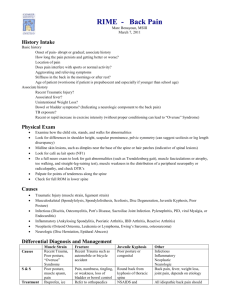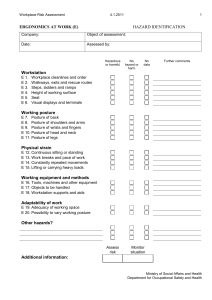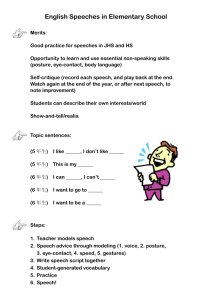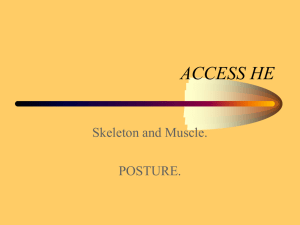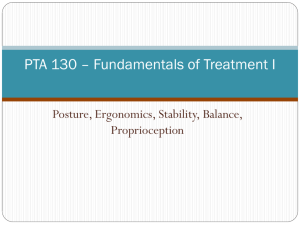File
advertisement
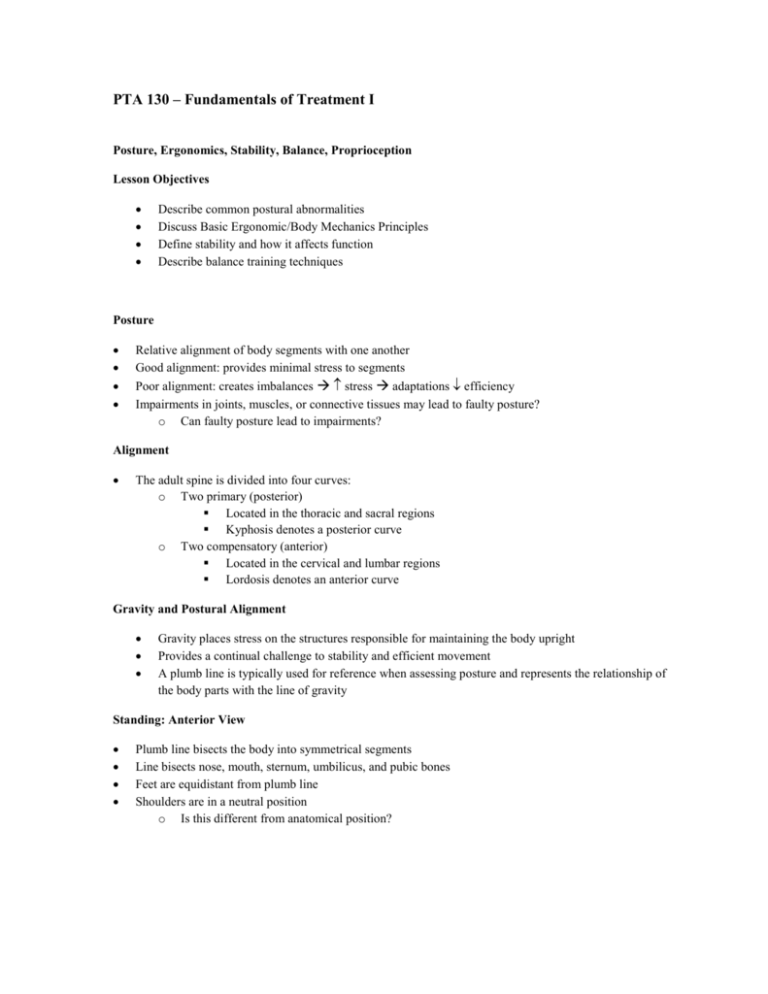
PTA 130 – Fundamentals of Treatment I Posture, Ergonomics, Stability, Balance, Proprioception Lesson Objectives Describe common postural abnormalities Discuss Basic Ergonomic/Body Mechanics Principles Define stability and how it affects function Describe balance training techniques Posture Relative alignment of body segments with one another Good alignment: provides minimal stress to segments Poor alignment: creates imbalances stress adaptations efficiency Impairments in joints, muscles, or connective tissues may lead to faulty posture? o Can faulty posture lead to impairments? Alignment The adult spine is divided into four curves: o Two primary (posterior) Located in the thoracic and sacral regions Kyphosis denotes a posterior curve o Two compensatory (anterior) Located in the cervical and lumbar regions Lordosis denotes an anterior curve Gravity and Postural Alignment Gravity places stress on the structures responsible for maintaining the body upright Provides a continual challenge to stability and efficient movement A plumb line is typically used for reference when assessing posture and represents the relationship of the body parts with the line of gravity Standing: Anterior View Plumb line bisects the body into symmetrical segments Line bisects nose, mouth, sternum, umbilicus, and pubic bones Feet are equidistant from plumb line Shoulders are in a neutral position o Is this different from anatomical position? Standing: Anterior View What should the therapist look for in this posture? o Level right to left: earlobes, shoulders, fingertips, nipples, iliac crests, patellae, medial malleoli o Patellae: directed forward o Feet: directed forward or out slightly o Knees and ankles: in line with each other o Knees: straight o Symmetrical muscle development Standing: Posterior View Plumb line bisects head and runs along spinous processes Level left to right: earlobes, shoulders, scapulae, hips, posterior superior iliac spine, gluteal fold, posterior knee creases, medial malleoli Scapulae lie against rib cage: T2-T7 Calcaneus: straight with Achilles perpendicular to floor Symmetrical muscles Weight equally distributed Standing: Lateral View In an ideal posture, the plumb line should fall: o Slightly anterior to the lateral malleolus o Slightly anterior to the axis of the knee joint o Through the greater trochanter o Through the bodies of the lumbar and cervical vertebrae o Through the shoulder joint o Through the lobe of the ear Standing: Lateral View Horizontal line between ASIS (anterior superior iliac spine) and PSIS (posterior superior iliac spine) Weight balanced between heel and toes Knees should be straight, but not locked Chin slightly tucked Chest up and forward Mild curve inward at cervical and lumbar spine Sitting Posture Improper sitting posture or prolonged sitting can have adverse affects on alignment Common faulty sitting posture issues: o Rounded shoulders o Forward head o Tight hip flexors o Shortened hamstring muscle length o Increased thoracic spine kyphosis o Decreased lumbar spine lordosis Ideal Sitting Posture Seat height: o Allows feet flat on floor—90° at hips, 90° at knees Seat depth: o Front edge 1 to 2 in. from posterior knee Back height: o To lower scapulae and support lumbar spine, thoracic spine Arms: o Allow shoulder relaxation and permit forearms to rest with elbows bent 90°, wrists in neutral, fingers able to rest comfortably on keyboard Common Faulty Postures Pelvic and Lumbar Region o Increased Lordosis Posture (Lordotic) o Relaxed or Slouched Posture o Flat Low-Back Posture Cervical and Thoracic Region o Increased Kyphosis Posture Round Back with Forward Head o Flat Upper Back and Neck Posture o Scoliosis Frontal Plane Deviations o Pelvic drop or elevation Increased Lordosis Posture Characterized by: o An increase in the lumbosacral angle o An increase in lumbar lordosis o Increase in anterior pelvic tilt and hip flexion Potential Muscle Impairments o What are they? Common Causes o Pregnancy o Obesity o Weak abdominal muscles Relaxed or Slouched Posture Also called swayback posture Characterized by: o A shift of the entire pelvic region anteriorly o Increased lordosis in the lower lumbar region o Increased kyphosis in the thoracic region o Usually present with a forward head posture Potential Muscle Impairments o What are they? Common Causes o Fatigue o Muscle weakness Flat Low-Back Posture Characterized by: o Decreased lumbosacral angle o Decreased lumbar lordosis o Hip Extension o Posterior pelvic tilt Potential Muscle impairments: o What are they? Common Causes: o Prolonged flexed posture in sitting or standing o Overemphasis of flexion biased exercises Round Back (Increased Kyphosis) with Forward Head Posture Characterized by: o Increased thoracic curve o Protracted scapula o Forward head Potential Muscle impairments: o What are they? Common Causes: o Slouching o Poor ergonomics at work station o Occupational or functional postures Flat Upper Back and Neck Posture Characterized by: o Decreased thoracic curve o Depressed scapula o Depressed clavicles o Decreased cervical lordosis Potential Muscle impairments: o What are they? Common Causes: o Not as common as other faulty postures o May occur with exaggerated military posture Scoliosis Characterized by: o Usually involves the thoracic and lumbar regions o May be asymmetry in the hips, pelvis, and lower extremities o Two types: Structural scoliosis and nonstructural scoliosis Scoliosis Structural Scoliosis o An irreversible lateral curvature with fixed rotation of the vertebrae o Rotation of the vertebral bodies is toward the convexity of the curve Nonstructural Scoliosis o Also called functional or postural scoliosis o It is reversible Through forward or side bending and with positional changes, muscle re-education, and realignment of the pelvis Scoliosis Potential Muscle Impairments o What are they? Common Causes o Structural scoliosis Neuromuscular disorders/diseases Osteopathic disorders Idiopathic disorders (unknown cause) o Nonstructural scoliosis Leg-length discrepancy Muscle guarding or muscle spasm Asymmetrical postures Pelvic Drop or Elevation Characterized by: o Elevated ilium on the long leg o Lowered ilium on the short leg Potential Muscle Impairments: o What are they? Common Causes: Deviations at the hip, knee, ankle, or foot Common functional problems: o Unilateral flat foot o Imbalances in the flexibility of muscles Further Postural Observations Knee and foot position/structure may also contribute to postural deviations Knees o Genu varus o Genu valgus o Genu recurvatum Feet o Pronation o Supination o Hallux valgus o Hammer toes Effects of Bad Posture on Tissue Health Changes in tissue occur slowly over time o Adaptation to stresses applied Shortening of some structures, lengthening of opposing structures Secondary weakness of both shortened and lengthened structures o Length–tension relationship-As a muscle shortens or lengthens beyond optimal length, strength decreases Results of Impaired Posture Efficiency of movement is impaired Stress on specific segments during sport activities increases Pain Muscles must work harder to maintain posture, increasing fatigue Individual becomes susceptible to injury Mobility impairment Decreased pulmonary endurance Posture Management What interventions can we perform to help manage patients with impaired posture? o Verbal, visual and tactile reinforcement o Cervical retraction to decrease forward head posture o Scapular retraction to decrease rounded forward shoulder posture o Instruct patient on neutral pelvis position in sitting and standing o What other treatment options might be appropriate for this patient population? Proper Ergonomics Ergonomics is the study of designing equipment and devices that fit the human body, its movements, and its cognitive abilities Especially important for our patients who spend most of the day sitting at a computer, performing repetitive movements throughout the day, or are required to lift at work Body Mechanics The way the body is positioned and used during activity Correct body mechanics makes the most effective use of the body’s forces and levers Incorrect mechanics leads to inefficient use and increases stress on the body segments Basic Principles Spine should remain straight. Pelvis remains in neutral. Lowering center of gravity increases stability. Broadening base of support increases stability. Feet are placed in direction of force application or acceptance. Core strength is vital for force transmission, transfer, and body support. Proper lifting Techniques Keep object close to body. Do NOT bend or twist your back. Let your legs do the work. Other Considerations Regarding Malalignment Sports increase postural deviations. o Anterior muscles are exercised more than posterior muscles o Unilateral activities Aging tends to increase deviations Joint hyper- or hypo-mobility muscle stresses. Scar tissue from injuries can cause imbalances. Site of pain may not be site of problem. Stability When the line of gravity from the center of mass falls within the base of support, a structure is stable Improved by lowering the center of gravity (COG) or increasing the base of support (BOS) When the COG falls outside the BOS, the structure either falls or some force must act to keep the structure upright Both inert and dynamic structures provide support to the body Postural Stability in the Spine Described in three subsystems: o Passive (inert) Bones and ligaments o Active Muscles o Neural control Muscle Control in the Lumbar Spine Importance of the transverse abdominis (TrA) and multifidus muscles as core stabilizers Provide support through attachments in the lumbar spine Studies have shown that these muscles are the first ones to become active when there is a postural disturbance When the TrA muscles develop tension, they act like a girdle of support around the abdomen and the lumbar vertebrae Postural Stabilization Core stabilization is the co-contracture of abdominal and lumbar region Back injuries often occur secondary to weak core musculature Balance Also known as postural stability The dynamic process by which the body’s position is maintained in equilibrium o Static equilibrium: the body is at rest o Dynamic equilibrium: the body is in steady-state motion Balance Biomechanical Components of Balance: o Base of Support (BOS)- Area within the perimeter of the contact surface between the feet and the support surface. o Center of Gravity (COG)- Central point within the limits of stability area Most adults COG is just anterior to S2 or at about 55% of a persons height o Limits of Stability- The sway boundaries in which an individual can maintain equilibrium without changing his or her BOS Balance A complex motor task Fundamental to posture and activity Three-component system: o Visual o Vestibular o Proprioception Balance (Visual System) Provides information regarding o Head position relative to the environment o Orientation of the head o Direction and speed of head movements Visual stimuli can be used to improve a person’s stability Balance (Vestibular System) Provides information about the position and movement of the head with respect to gravity and inertial forces On its’ own, the vestibular system cannot provide information about the position of the body Additional information from mechanoreceptors must be sent to the CNS in order to develop a true picture of the orientation of the head relative to the body Balance (Proprioception) Provides information about the position and motion of the body and body parts relative to each other and the support surface Muscle spindles and Golgi tendon organs play an important role in maintaining balance when on a firm surface What about when placed on a moving or unsteady surface? Balance Sensory Components of Balance o Requires information from the Central Nervous System to select, suppress, and combine appropriate inputs Musculoskeletal Components of Balance o Provide coordination of postural stability by key muscle groups Motor Strategies for Balance Control The body must adjust its position in space in order to maintain balance Three primary movement strategies to recover balance in response to sudden perturbations: o Ankle, hip, and stepping strategies CNS uses three movement systems to regain balance: o Reflex – First response, controlled by spinal cord o Voluntary systems – Dependent on task parameters o Automatic – Relatively quick responses, but require coordination of responses among body regions Balance Strategies Automatic Postural Reactions (Reflexive Muscle Contractions) are used to maintain balance o Ankle strategy: small disturbance, slow-speeds uses ankle dorsiflexion and plantar flexion to redistribute body weight o Hip strategy: rapid or large disturbances, compensatory hip flexion and extension to redistribute body weight o Stepping Strategy: large disturbance displaces center of mass beyond limits of control and a step enlarges the base of support Balance Techniques to Improve Ankle Strategieso Unilateral Standing – One-foot standing or unstable surface activity. Techniques to Improve Hip Strategieso Unilateral Standing on unstable surface with high-sway frequencies. Techniques to Improve Stepping Strategieso Stepping activity such as step onto stool and step-overs Balance Balance Assessment Tools: o Romberg o Unilateral stand o Functional Reach o Berg Balance o Tinetti Balance o Timed Up and Go Examination of Sensory Organization o Assessment of three sensory inputs (proprioceptive, visual, and vestibular) Rhomberg and Single Leg Stand Rhombergo The subject stands with feet together, eyes open and hands by the sides o The subject closes the eyes while the examiner observes for a full minute Single leg stand (Stork stand)

